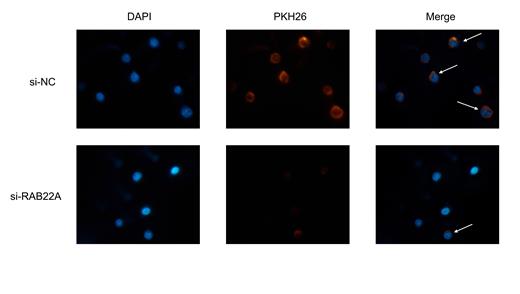Background: Multiple myeloma(MM)is an incurable malignant plasma cell disease in the blood system. After remission, patients will still have multiple recurrences, and the remission time after each recurrence will gradually become shorter. RAB22A is a member of RAS oncogene family, and there is no relevant research in MM at present. In this study, we explored the role of RAB22A in exosome secretion, Epithelial-mesenchymal transition(EMT)and immune regulation.
Methods: We obtained MM samples from GEO data sets (GSE5900, GSE4581 and GSE146649), and analyzed the difference of expression of RAB22A. We downloaded the “IOBR” package, and used the “PCA” and “ssGSEA” algorithms to calculate the EMT scores and exosome scores of the high/low RAB22A expression groups. The “CIBERSORT” package was used to analyze the infiltration of immune cells. RT-PCR and Western-blot were used to verify the expression level of RAB22A in normal people and MM patients. After regulating the expression of RAB22A, the exosomes of MSC were collected for immunofluorescence staining and CCK-8 experiment.
Results: The expression level of RAB22A in SMM and MM patients was significantly higher than that in normal people and MGUS patients, and the expression level of RAB22A in relapse MM patients was significantly higher than that in newly diagnosed patients. We calculated the EMT score and exosomes score by “IOBR” package. The results showed that the EMT score and exosomes score of high RAB22A group were significantly higher than those of low RAB22A group, and the exosomes score of MSC in recurrent patients was significantly higher than that of newly diagnosed patients. In addition, the infiltration levels of Monocyte, NK cells resting, Eosinophils, T cells regulatory (Treg) and T cells CD4 memory activated were positively correlated with RAB22A, while plasma cells and T cells gamma delta were negatively correlated with RAB22A. The expression levels of m6A genes (METTL14, VIRMA, RBM15 and FMR1) in the high RAB22A group were significantly higher than those in the low RAB22A group. We constructed a nomogram based on m6A genes significantly related to RAB22A to predict the risk value of high RAB22A expression, and the calibration curve showed that the nomogram had good prediction ability. We screened sensitive drugs according to the difference of IC50 values between high and low RAB22A groups, and found that cisplatin, Doxorubicin and bcl-2 inhibitors had higher sensitivity in low RAB22A group. Finally, we verified the above results in the samples of our center. The results showed that the expression level of RAB22A in MM patients was significantly higher than that of donors. After down-regulating the expression of RAB22A in MM-MSC, the secretion of exosomes decreased(Figure 1). Down-regulation of RAB22A reduced the proliferation of MM cells, and the addition of exosomes of MM-MSC partially reversed this effect.
Conclusion: RAB22A is a potential therapeutic target to improve the prognosis of MM, which is closely related to exosome secretion, EMT and immune cell infiltration.
Disclosures
No relevant conflicts of interest to declare.


